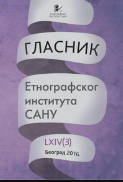Миграције, интеграција и брачна пракса код Горанаца
Migration, Integration and Marriage Practices among the Gorani
Author(s): Jadranka Đorđević-CrnobrnjaSubject(s): Recent History (1900 till today), Cultural Anthropology / Ethnology, Migration Studies, Ethnic Minorities Studies
Published by: Етнографски институт САНУ
Keywords: the Gorani; migration; integration; ethnic homogamy/heterogamy; village endogamy; Belgrade; Tutin;
Summary/Abstract: For the most part, the Gorani enter ethnically homogeneous marriages. Marrying into the same village is also a common practice. This village endogamy has continuously been present in the Gorani community for a longer period of time. Migration of population from the Gora region has been characteristic for the most of the 20th century and the beginning of the 21st. Considering the fact that Gora is an area of intensive and populous emigration and that migrations can influence changes in the current practices of choosing the spouse, the issue of the relation between the Gorani migrations and ethnic homogamy/endogamy seems entirely relevant. This also stands true given that the majority of the informants endorse the practice of homogamous marriages, believing that it contributes to harmonious relations in the marriage and to practicing of the Gorani community’s cultural specificities. In this paper I am presenting and interpreting the practices of choosing marital partners among the Gorani living in Belgrade and Tutin from the second half of the 20th until the beginning of the 21st century. Based on the analysis of the empirical data and relevant literature I argue that migrations have not significantly influenced the practice of the selection of the spouse, as well as that ethnically homogamous marriages are not slowing down the process of integration.
Journal: Гласник Етнографског института САНУ
- Issue Year: LXVI/2018
- Issue No: 3
- Page Range: 581-600
- Page Count: 20
- Language: Serbian

